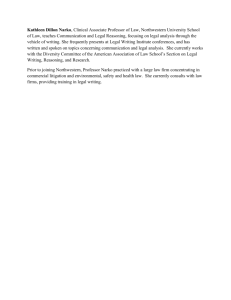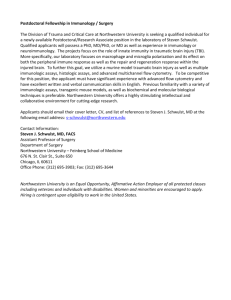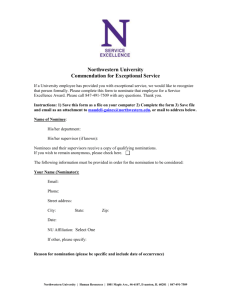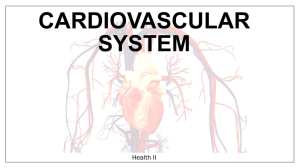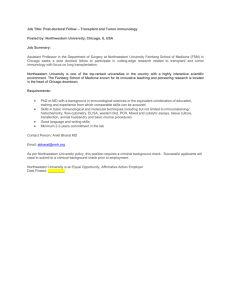Tissue Valves in Patients <65 years old: A Viable Alternative to
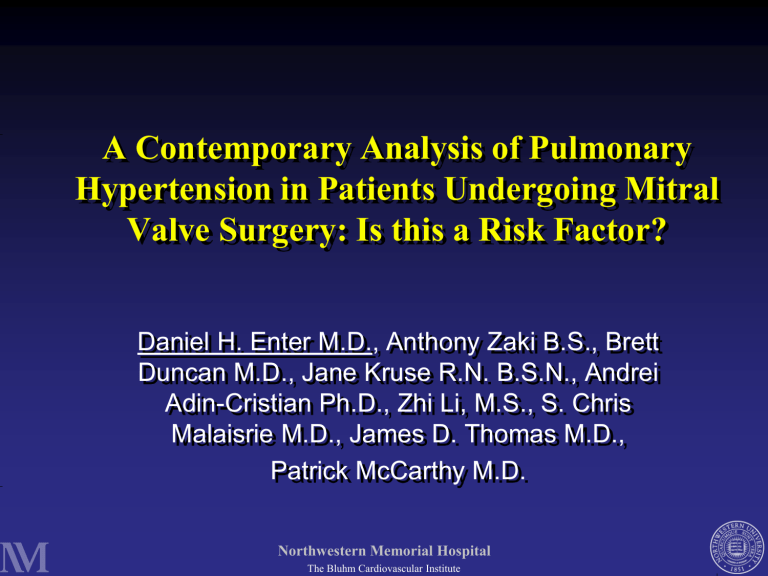
A Contemporary Analysis of Pulmonary
Hypertension in Patients Undergoing Mitral
Valve Surgery: Is this a Risk Factor?
Daniel H. Enter M.D., Anthony Zaki B.S., Brett
Duncan M.D., Jane Kruse R.N. B.S.N., Andrei
Adin-Cristian Ph.D., Zhi Li, M.S., S. Chris
Malaisrie M.D., James D. Thomas M.D.,
Patrick McCarthy M.D.
Northwestern Memorial Hospital
The Bluhm Cardiovascular Institute
Pulmonary Hypertension
1.
Pulmonary hypertension (pHTN) is elevated arterial pressures in the pulmonary circulation, specifically systolic pulmonary arterial pressure
(PASP) greater than 35 mm Hg.
2.
Severe pulmonary hypertension has been identified in the Euroscore data as a factor for 30 day mortality 1 .
3.
However, contemporary surgery may reduce that risk.
1 Group, E.S. EuroSCORE II Calculator . European System for Cardiac Operative Risk Evaluation, http://www.euroscore.org/calc.html.
Northwestern Memorial Hospital
The Bluhm Cardiovascular Institute
2014 AHA/ACC Guidelines for the
Management of Patients With Valvular
Heart Disease
•
Severe pHTN (PASP >50 mm Hg) is considered a class IIa indication for surgery in chronic severe MR 1
•
Level of Evidence B
1 Nishimura, R.A., et al. J Thorac Cardiovasc Surg, 2014. 148 (1): p. e1-e132.
Northwestern Memorial Hospital
The Bluhm Cardiovascular Institute
N= 3342, Multivariate analysis
92.4% Isolated CABG or AVR
J Thorac Cardiovasc Surg, 2013. 146 (3): p. 631-7.
6.3% MV surgery, not reported separately
Northwestern Memorial Hospital
The Bluhm Cardiovascular Institute
N=873
Mitral regurgitation
Multivariate analysis
J Thorac Cardiovasc Surg, 2011. 142 (6): p. 1439-52.
Northwestern Memorial Hospital
The Bluhm Cardiovascular Institute
Hypotheses
1.
Pulmonary HTN itself does not increase perioperative or long-term mortality in MV surgery patients.
2.
Addition of TV surgery does not increase mortality.
Northwestern Memorial Hospital
The Bluhm Cardiovascular Institute
Northwestern pHTN Data
•
Mitral Valve surgery 2004-2014
•
Exclusion: TAVR, VADS, Transplants, Trauma, CARD refusal, Endocarditis
1571 patients )
No PHTN
(PASP < 35 mmHg)
496 (29%)
Moderate
(PASP 35-49 mmHg)
600 (35%)
Severe
(PASP 50-79 mmHg)
426 (25%)
Extreme
(PASP > 80 mmHg)
49 (3%)
143 (8%) unknown
Northwestern Memorial Hospital
The Bluhm Cardiovascular Institute
Unmatched Groups
Variable
No
(<35mmHg)
(N=496)
Moderate (35-
49mmHg)
(N=600)
59.4
±
13.9 65.0
±
12.9 Age
Gender (female), No. (%) 202 (41%) 279 (47%)
Ejection Fraction, Median
(Q1, Q3)
60.0 (53.0,
65.0)
NYHA Class III IV, No. (%) 112 (23%)
CABG, No. (%)
Tricuspid Valve Surgery,
No. (%)
118 (24%)
42 (8%)
57.0 (45.0,
61.5)
233 (39%)
178 (30%)
138 (23%)
Severe
(50-79mmHg)
(N=426)
68.0
±
12.1
213 (50%)
55.0 (43.0, 63.0)
236 (56%)
139 (33%)
189 (44%)
Extreme
(>=80mmHg)
(N=49)
P-value
65.7
±
13.1 <.001
29 (59%) 0.008
60.0 (53.0,
65.0)
<.001
32 (67%) <.001
16 (33%) 0.021
23 (47%) <.001
Northwestern Memorial Hospital
The Bluhm Cardiovascular Institute
Unmatched pHTN
30d Mortality: 4% vs. 1% (p<0.01) p<0.0001
Group Year1 Year2 Year3 Year4 Year5
No
Yes
97.1%
90.2%
95.5%
87.8%
94.3%
85.6%
93.2%
83.8%
92.8%
81.3%
FU
4.0±2.8
4.1±2.8
Northwestern Memorial Hospital
The Bluhm Cardiovascular Institute
Unmatched pHTN
30d Mortality: 12% , 4% , 3% , 1% (p<0.001) p<0.0001
No
Group Year1 Year2 Year3 Year4 Year5 FU
97.1% 95.5% 94.3% 93.2% 92.8% 4.0±2.8
Moderate 93.5% 91.8% 89.5% 88.1% 86.7% 4.4±2.7
Severe 87.1% 83.8% 81.5% 78.9% 74.5% 3.7±2.7
Extreme 74.9% 72.7% 72.7% 72.7% 72.7% 3.5±3.0
Northwestern Memorial Hospital
The Bluhm Cardiovascular Institute
Propensity Matched pHTN Analysis
•
PS-Matched on:
Age
BSA
-
Creatinine
-
Ambler score
-
Gender
CAD
prior MI
DM
HL
HTN
-
COPD
-
CVA
-
Prior CABG
Prior valve surg
A-fib history
NYHA III/IV
Elective
MV fnc class
-
TV Surgery
Northwestern Memorial Hospital
The Bluhm Cardiovascular Institute
PS-matched Operative Data
Variable
Clamp Time (min), Median (Q1, Q3)
CABG, No. (%)
Aortic Valve Surgery, No. (%)
Tricuspid Valve Surgery, No. (%)
Pulmonic Valve Surgery, No. (%)
Mitral Valve Repair, No. (%)
No PHTN
(N=420)
81.0 (66.0, 110.0)
115 (27%)
66 (16%)
41 (10%)
0 (0%)
347 (83%)
PHTN
(N=420)
P-value
90.0 (67.0, 118.0) 0.09
120 (29%)
73 (17%)
42 (10%)
1 (0%)
345 (82%)
0.70
0.52
0.91
0.32
0.86
Northwestern Memorial Hospital
The Bluhm Cardiovascular Institute
PS-matched Operative Data
Carpentier’s Classification of
Mitral Regurgitation
. Type I
. Type II
. Type IIIa
. Type IIIb
No PHTN
(N=420)
46 (11%)
254 (60%)
39 (9%)
34 (8%)
PHTN
(N=420)
42 (10%)
262 (62%)
39 (9%)
41 (10%)
Pvalue
0.65
0.57
1.00
0.40
Northwestern Memorial Hospital
The Bluhm Cardiovascular Institute
PS-matched Postoperative Data
Variable
Total ICU Hours, Median (Q1, Q3)
Total Length of Stay (Days), Median
(Q1, Q3)
Discharged to Home, No. (%)
Readmission within 30 Days, No. (%)
Operative Mortality, No. (%)
30-Day Mortality, No. (%)
Ambler Score (%)
STS Risk Score (%), Median (Q1, Q3)
All-Cause Long-Term Mortality, No. (%)
No PHTN
(N=420)
31.3 (24.3, 60.0)
6.0 (5.0, 8.0)
355 (86%)
45 (11%)
7 (2%)
6 (1%)
6.0
±
7.8
0.6 (0.3, 1.7)
28 (7%)
PHTN
(N=420)
Pvalue
31.4 (24.1, 68.8) 0.62
6.0 (5.0, 9.0) 0.32
351 (84%)
50 (12%)
8 (2%)
9 (2%)
6.4
±
7.3
0.9 (0.4, 2.1)
38 (9%)
0.64
0.59
0.79
0.43
0.46
0.11
0.20
Northwestern Memorial Hospital
The Bluhm Cardiovascular Institute
Propensity Matched pHTN Analysis
30d Mortality: 2% vs. 1% (NS, p=0.43) p=0.39
Group Year1 Year2 Year3 Year4 Year5
No 96.5% 95.1% 93.6% 92.7%
FU
92.2% 4.0±2.8
Yes 95.2% 94.6% 92.7% 91.3% 88.9% 4.6±2.7
Northwestern Memorial Hospital
The Bluhm Cardiovascular Institute
p=0.45
PS-Matched by Severity
Severe
(PASP 50-79 mmHg)
Northwestern Memorial Hospital
The Bluhm Cardiovascular Institute
p=0.022
PS-Matched by Severity
Extreme
(PASP > 80mmHg)
Northwestern Memorial Hospital
The Bluhm Cardiovascular Institute
Post-surgical pHTN p=0.7
p<0.0001
p<0.0001
p<0.0001
Northwestern Memorial Hospital
The Bluhm Cardiovascular Institute
Hypotheses
1.
Pulmonary HTN itself does not increase perioperative or long-term mortality in MV surgery patients.
2.
Addition of TV surgery does not increase mortality.
Northwestern Memorial Hospital
The Bluhm Cardiovascular Institute
TV Surgery in pHTN, Unmatched
30d Mortality: 5% vs. 3% (NS, p=0.06) p<0.0001
Group
PulHTN, No TV
PulHTN, TV
Year1 Year2 Year3 Year4 Year5 FU
93.5% 91.3% 88.9% 87.3% 85.5% 4.2±2.7
83.0% 78.7% 72.7% 76.6% 72.7% 3.7±2.8
Northwestern Memorial Hospital
The Bluhm Cardiovascular Institute
TV Surgery in pHTN, Propensity Matched
30d Mortality; 5% vs. 4% (NS, p=0.8) p=0.97
Group
PulHTN, No TV
PulHTN, TV
Year1 Year2 Year3 Year4 Year5 FU
89.3% 83.7% 80.8% 78.3% 77.3% 3.7±2.7
84.7% 82.2% 81.5% 79.8% 77.1% 3.8±2.9
Northwestern Memorial Hospital
The Bluhm Cardiovascular Institute
Limitations
•
Right heart catheterizations as primary source, echocardiogram as second choice
•
Retrospective series
•
Single institution
Northwestern Memorial Hospital
The Bluhm Cardiovascular Institute
Conclusions
•
Severe pulmonary hypertension is not an independent risk factor for short or long-term mortality in patients undergoing mitral valve surgery.
•
Tricuspid valve surgery does not increase mortality in patients with pulmonary hypertension undergoing mitral valve surgery.
•
Pulmonary hypertension itself is not a reason to deny patients mitral valve surgery.
Northwestern Memorial Hospital
The Bluhm Cardiovascular Institute
A Contemporary Analysis of Pulmonary
Hypertension in Patients Undergoing Mitral
Valve Surgery: Is this a Risk Factor?
Daniel H. Enter M.D., Anthony Zaki B.S., Brett
Duncan M.D., Jane Kruse R.N. B.S.N., Andrei
Adin-Cristian Ph.D., Zhi Li, M.S., S. Chris
Malaisrie M.D., James D. Thomas M.D.,
Patrick McCarthy M.D.
Northwestern Memorial Hospital
The Bluhm Cardiovascular Institute
